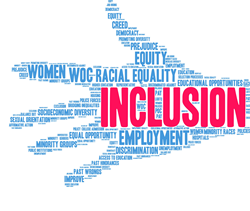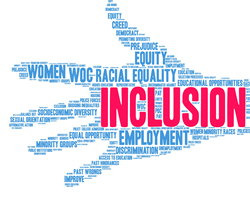
The cost of excessive care due to health disparities is estimated to be upwards of $93 billion.
This is a difficult time to address inequity but the earlier a hospital can adopt cultural competency, inclusive leadership strategies, the faster improved outcomes will emerge.
OAKLAND, Calif. (PRWEB)
February 24, 2021
The statistics around higher rates of death and poorer health outcomes for minorities and people of color are undeniable. As a result of a lack of culturally competent care, healthcare leaders and administrators often miss an important point: health inequities cost hospitals real money(1). Based on recent research, the cost of excessive care due to health disparities is estimated to be upwards of $93 billion and another estimated $175 million in economic losses due to shortened life spans.(2) Poor treatment plans, medical errors as a result of bias—conscious or unconscious—increase lawsuits and might put a facility’s accreditation in jeopardy.
Health equity is a patient safety issue.(3) “Today, hospitals are overwhelmed and don’t have the bandwidth to face this problem head on, and that puts the hospital at risk,” says Dr. Maria Hernandez, President and CEO of Impact4Health. “In this difficult environment, it will take time to course correct but it’s vital to the wellbeing of Black and Latino patients in particular.”
The problems are manifold and cross-cultural, involving unconscious bias, social barriers and not surprisingly, language. Very simply, diversity and inclusion inequities present risks beyond patient care including crippling financial penalties, skyrocketing lawsuits, and unwanted investigations from regulatory agencies. (4)
Quality communication between patients and physicians is critical to achieving positive outcomes. Language is a great example of how inequity serves as a catalyst for problems. (5) For example, doctors are legally required by the Americans with Disabilities Act (ADA) to have interpreters. (6) But realistically, interpreters aren’t always available. Beyond the fundamental conflict of differing languages, doctors also encounter patients who don’t necessarily need an interpreter but might not understand what is happening.
“It’s important to know that language preferences can put minorities at greater risk for more medical errors,” explains Dr. Hernandez. “When a physician is treating a Limited English Proficient patient, who doesn’t have the capacity to clearly communicate or understand, the doctor must be very careful regarding that patient’s adherence to the course of care, use of medications and follow-up treatment.”
On the part of the physician, explains Hernandez, potential interventions might include:
- Requesting an interpreter through the hospital’s appropriate channel.
- Waiting for the interpreter if the patient’s condition is stable.
- Asking the patient to repeat the instructions they have been given to ensure comprehension.
- Asking a family member or caregiver to serve as the patient’s advocate to confirm they can support the patient’s adherence to treatment
- Telemedicine presents a potential solution, but Dr. Hernandez warns that issues like computer literacy skills, regionalism and indigenous lexicon may lead to misinterpretation, despite the best intentions.
To help hospitals and healthcare providers understand and address health inequities and their consequences, Impact4Health uses a comprehensive assessment to improve health equity that links to improved health outcomes. Put simply, data reveals disparity. The Inclusion Scorecard for Population Health is a free online assessment featuring best practices to advance health equity. The assessment is a first step in determining what opportunities exist to support diverse and vulnerable populations. Embedded in the Scorecard are key data to gather to determine where inequities may exist. The next step is training in Inclusion Leadership, where Impact4Health trains professionals to recognize and address cultural challenges and more closely engage with the community at large.
“When the hospital begins to connect the dots on quality of care and health equity, they are not resistant, but they’re often overwhelmed. This is a difficult time to address inequity but the earlier a hospital can adopt cultural competency, inclusive leadership strategies, the faster improved outcomes will emerge,” explains Dr. Hernandez.
Risk is inherent in every industry and that includes healthcare but not addressing the inequities related to diversity and inclusion borders on negligence. Diversity and inclusion are not just a matter of social equity but generate authentic safety issues with very real consequences for patients, physicians, C-suite executives and other healthcare professionals. Medical centers must be reminded of the importance of diversity and inclusion, and the ethical principles that guide the medical field—justice for all people, showing respect for others and the simplest rule of all: first, do no harm. (7)
About Impact4Health
Impact4Health is a multidisciplinary team of community psychologists, public health researchers, physicians and health educators who promote health equity, working in partnership with hospitals, public health departments, and healthcare insurance providers. Strategies employed include training in cross-cultural health, inclusive leadership, and implementing the Inclusion Scorecard for Population Health. For more information, please visit us as http://www.Impact4Health.com.
1. Centers for Disease Control and Prevention; “Health Equity Considerations and Racial and Ethnic Minority Groups” cdc.gov/coronavirus/2019-ncov/community/health-equity/race-ethnicity.html Accessed 14 FEB 2021
2. Kellog Foundation; The Business Case for Racial Equity: A Strategy for Growth. altarum.org/sites/default/files/uploaded-publication-files/WKKellogg_Business-Case-Racial-Equity_National-Report_2018.pdf Accessed 14 FEB 2021
3. Safety and Health Magazine; “Diversity, equity and inclusion in the workplace: ‘A safety issue’” safetyandhealthmagazine.com/articles/20307-diversity-equity-and-inclusion-in-the-workplace-a-safety-issue?page=2 Accessed 14 FEB 2021
4. National Institutes of Health; Addressing Health and Health-Care Disparities: The Role of a Diverse Workforce and the Social Determinants of Health; ncbi.nlm.nih.gov/pmc/articles/PMC3863703/ Accessed 14 FEB 2021
5. National Institutes of Health; “Providing Interpreters for Patients with Hearing Disabilities: ADA Requirements” ncbi.nlm.nih.gov/pmc/articles/PMC3472899/ Accessed 14 FEB 2021
6. Florida Health; Are Doctors Required to Provide Interpreters for Medical Visits and Other Medical-Related Situations? floridahealth.gov/programs-and-services/childrens-health/cms-plan/for-health-care-providers/_documents/ada-questions.pdf Accessed 14 FEB 2021
7. National Institutes of Health; “First do no harm; then try to prevent it“ ncbi.nlm.nih.gov/pmc/articles/PMC2658469/ Accessed 14 FEB 2021
Share article on social media or email:

